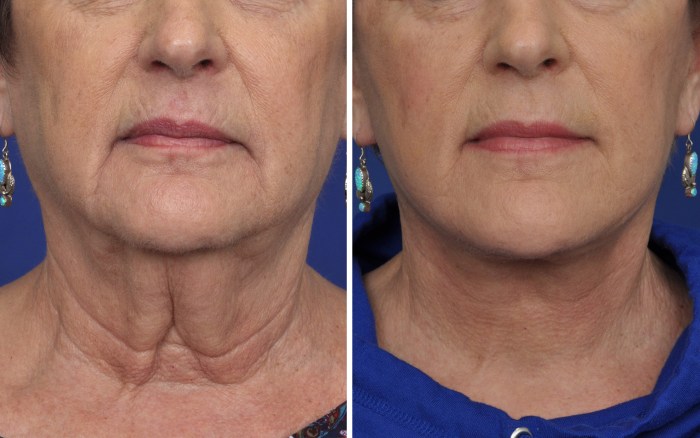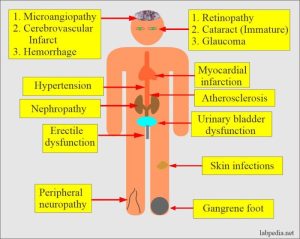
Embark on a journey through the facelift procedure, where wrinkles vanish and confidence soars. Discover the secrets behind this transformative cosmetic surgery that leaves you looking and feeling rejuvenated.
As we delve deeper, you’ll uncover the nuances of different facelift techniques, the benefits that await, and how to navigate the risks for a safe and successful outcome.
Facelift Procedure Overview
Facelift, also known as rhytidectomy, is a cosmetic surgical procedure aimed at reducing the visible signs of aging on the face and neck. It involves tightening the skin and underlying tissues to create a more youthful appearance.
Types of Facelift Techniques
- Traditional Facelift: This technique involves making incisions along the hairline and around the ears to lift and reposition the underlying tissues.
- Mini Facelift: A less invasive option that targets specific areas of the face, typically using smaller incisions.
- Thread Lift: This non-surgical technique involves inserting barbed sutures under the skin to lift and tighten sagging areas.
Typical Candidates for Facelift
Generally, ideal candidates for a facelift are individuals who are in good overall health, have realistic expectations, and are bothered by the appearance of sagging skin, deep creases, and jowls on their face and neck. It is important for candidates to consult with a board-certified plastic surgeon to determine if they are suitable for the procedure.
Benefits of Facelift Surgery
Facelift surgery offers numerous benefits for individuals looking to rejuvenate their appearance and boost their self-confidence. Here are some of the key advantages of undergoing a facelift procedure:
Improved Facial Appearance
- Facelift surgery can effectively reduce sagging skin, wrinkles, and other signs of aging on the face, resulting in a more youthful and refreshed appearance.
- By tightening the facial muscles and tissues, a facelift can enhance facial contours and restore a firmer, more defined jawline.
Long-lasting Results
- Unlike non-surgical options such as fillers or Botox, facelift surgery provides long-lasting results that can significantly turn back the clock on aging.
- The effects of a facelift can last for many years, helping patients enjoy a more youthful look for an extended period of time.
Boost in Self-confidence
- Many patients report a significant boost in self-confidence and self-esteem following a successful facelift procedure.
- Feeling more satisfied with their appearance can lead to improved overall well-being and a more positive outlook on life.
Enhanced Psychological Well-being
- Facelift surgery can have a positive impact on a patient’s mental health, reducing feelings of anxiety, depression, and self-consciousness related to visible signs of aging.
- Patients often experience increased happiness and satisfaction with their appearance, leading to a better quality of life.
Risks and Complications
Facelift surgery, like any other surgical procedure, carries certain risks and potential complications. It is important for patients to be aware of these risks before undergoing the surgery.
Infection
- Infections can occur post-surgery, leading to complications.
- To mitigate this risk, surgeons prescribe antibiotics and provide post-operative care instructions.
- Following all post-operative care instructions is crucial to minimize the risk of infection.
Nerve Damage
- Nerve damage is a potential risk during facelift surgery.
- Experienced surgeons take precautions to avoid damaging facial nerves.
- Choosing a qualified and experienced surgeon reduces the risk of nerve damage.
Scarring
- Scarring is a common risk associated with facelift surgery.
- Surgeons use techniques to minimize visible scarring.
- Proper wound care can help in reducing the appearance of scars over time.
Bleeding and Hematoma
- Bleeding and hematoma (blood clots) can occur after the surgery.
- Surgeons monitor patients closely post-surgery to detect and address any bleeding or hematoma.
- Following post-operative care instructions is essential to prevent excessive bleeding.
Anesthesia Risks
- General anesthesia poses risks such as allergic reactions or adverse effects.
- Qualified anesthesiologists administer anesthesia to minimize risks.
- Prior medical history assessment helps in identifying any potential risks related to anesthesia.
Choosing the Right Surgeon
- The risk of complications can be significantly reduced by choosing a qualified and experienced surgeon.
- Researching the surgeon’s credentials, experience, and patient reviews is crucial.
- Consulting with multiple surgeons and asking relevant questions can help in selecting the right surgeon for a facelift.
Recovery Process
After a facelift procedure, the recovery process is crucial for optimal healing and achieving the desired results. Patients should follow specific post-operative care instructions to ensure a smooth recovery and minimize any risks or complications that may arise.
Post-Operative Care
- Keep your head elevated: It is essential to keep your head elevated, even while sleeping, to reduce swelling and promote proper healing.
- Follow the surgeon’s instructions: Make sure to follow all post-operative care instructions provided by your surgeon, including when to remove bandages and any medications prescribed.
- Avoid strenuous activities: Refrain from engaging in strenuous activities, heavy lifting, or bending over for a few weeks post-surgery to avoid putting strain on the incision sites.
- Attend follow-up appointments: Regularly attend follow-up appointments with your surgeon to monitor your healing progress and address any concerns or complications promptly.
Managing Pain and Swelling
- Take prescribed pain medication: Your surgeon may prescribe pain medication to manage any discomfort during the initial stages of recovery. Follow the dosage instructions carefully.
- Apply cold compresses: Use cold compresses on the swollen areas to reduce inflammation and relieve pain. Make sure to follow proper guidelines for applying cold therapy.
- Avoid alcohol and smoking: Alcohol and smoking can hinder the healing process and increase the risk of complications. It is advisable to refrain from these substances during the recovery period.
- Stay hydrated and eat a healthy diet: Drink plenty of water and consume nutritious foods to support your body’s healing process and promote overall well-being.
Cosmetic Surgery
Cosmetic surgery encompasses a wide range of procedures aimed at enhancing one’s appearance and boosting self-confidence. Facelifts are just one of the many options available to individuals looking to rejuvenate their look and turn back the hands of time.
Relationship with Other Cosmetic Surgeries
Facelift procedures can often be combined with other cosmetic surgeries to achieve comprehensive results. Here are some popular procedures that are commonly done in conjunction with facelifts:
- Rhinoplasty (Nose Job): While a facelift focuses on the lower face and neck, rhinoplasty can address imperfections in the nose, creating overall facial harmony.
- Eyelid Surgery (Blepharoplasty): This procedure can help address sagging eyelids or under-eye bags, complementing the rejuvenating effects of a facelift.
- Facial Fillers or Botox: Non-surgical options like fillers and Botox can be used to enhance the results of a facelift by addressing fine lines and wrinkles.
Comparison with Other Popular Cosmetic Procedures
Facelifts are often compared and contrasted with other popular cosmetic surgeries available. Let’s take a closer look at how facelifts stack up against some of these procedures:
| Procedure | Facelift | Differences |
|---|---|---|
| Rhinoplasty | Focuses on lower face and neck | Targets imperfections in the nose |
| Breast Augmentation | Enhances facial appearance | Increases breast size and shape |
| Liposuction | Addresses signs of aging | Removes excess fat from targeted areas |
Enhancing Results of Other Surgeries
Facelifts can play a crucial role in enhancing the results of other surgeries by providing a more youthful and harmonious overall appearance. Whether combined with rhinoplasty, eyelid surgery, or non-surgical treatments, a facelift can complement and elevate the effects of these procedures, resulting in a more comprehensive transformation.
Foot Health
When undergoing a facelift procedure, it is essential to consider the impact it may have on your foot health. Although it may seem unrelated, certain factors during and after surgery can affect your feet. Let’s explore some common foot issues that may arise post-facelift and how to address them, along with tips for maintaining good foot health before and after the surgery.
Common Foot Issues Post-Facelift
- Swelling: After a facelift, you may experience swelling in various parts of your body, including your feet. To reduce swelling in your feet, elevate them above heart level and apply cold compresses.
- Decreased Mobility: Limited movement post-surgery can lead to stiffness in your feet. Perform gentle foot exercises and stretches to improve mobility and prevent stiffness.
- Edema: Fluid retention can cause edema in the feet. Avoid sitting or standing for long periods, and wear compression socks to promote circulation and reduce swelling.
Tips for Maintaining Good Foot Health
- Stay Active: Engage in low-impact exercises like walking or swimming to promote circulation and strengthen the muscles in your feet.
- Proper Footwear: Choose comfortable and supportive shoes to prevent foot pain and discomfort. Avoid high heels or tight-fitting shoes during the recovery period.
- Regular Foot Care: Keep your feet clean and moisturized to prevent dryness and cracking. Trim your toenails carefully to avoid ingrown toenails.
Heart Disease
Heart disease is a serious condition that can have implications on various medical procedures, including facelift surgery. It is important to consider the potential risks and complications associated with heart disease when contemplating a facelift procedure.
Impact on Heart Health
- Facelift surgery is a major procedure that can put stress on the cardiovascular system, potentially leading to complications for individuals with pre-existing heart conditions.
- Patients with a history of heart disease may be at a higher risk for experiencing issues such as heart attack, stroke, or irregular heartbeat during or after surgery.
Eligibility for Facelift Surgery
- Individuals with heart disease may not be suitable candidates for facelift surgery due to the increased risk of complications.
- It is essential for patients to undergo thorough medical evaluations and consultations with their healthcare providers to determine if they are physically fit for the procedure.
Recommendations for Patients with Heart Disease
- Prior to considering a facelift, individuals with heart disease should work closely with their cardiologist and plastic surgeon to assess the risks and benefits of the surgery.
- It is important to follow all pre-operative and post-operative instructions provided by healthcare professionals to minimize the chances of complications.
- Patients with heart disease should prioritize their cardiovascular health by following a heart-healthy diet, engaging in regular exercise, and managing stress levels to improve overall well-being.
Health Diabetes
Diabetes is a common health condition that can impact various aspects of a person’s life, including their ability to undergo surgical procedures like a facelift. It is important for individuals with diabetes to carefully consider the potential risks and challenges before deciding to undergo a facelift surgery.
Considerations for Individuals with Diabetes
- Before undergoing a facelift procedure, individuals with diabetes should consult with their healthcare provider to ensure their condition is well-managed and stable.
- Proper blood sugar control is essential to reduce the risk of complications during and after surgery.
- The surgical team should be informed about the patient’s diabetes status and any medications they are taking to adjust the treatment plan accordingly.
Impact of Diabetes on Healing Process
- Diabetes can impair the body’s ability to heal properly, leading to delayed wound healing and increased risk of infection post-surgery.
- High blood sugar levels can also affect circulation, which is crucial for the healing process, potentially prolonging recovery time.
- Individuals with diabetes may experience slower recovery and may require additional monitoring and care to ensure proper healing.
Managing Diabetes During Recovery
- It is important for individuals with diabetes to closely monitor their blood sugar levels during the recovery period following a facelift surgery.
- Proper nutrition, hydration, and medication management are essential to support the healing process and reduce the risk of complications.
- Regular follow-up appointments with healthcare providers are crucial to assess healing progress and address any concerns or issues that may arise.
Eating Disorders

Eating disorders are serious mental health conditions that can have a significant impact on a person’s physical and emotional well-being. When it comes to considering cosmetic procedures such as a facelift, individuals with eating disorders may face unique challenges and considerations.
Relationship between Eating Disorders and Facelift Procedures
- Individuals with eating disorders may have distorted body image perceptions, leading them to seek out cosmetic procedures to alter their appearance.
- The pressure to achieve unrealistic beauty standards can be heightened for those with eating disorders, potentially influencing their decision to undergo a facelift.
- Eating disorders can also impact the recovery process post-facelift, as proper nutrition and self-care are crucial for healing.
Influence on Decision to Undergo a Facelift
- Feelings of low self-esteem and dissatisfaction with one’s appearance, common among individuals with eating disorders, may drive them to pursue cosmetic surgery.
- The desire to control and change one’s body may manifest in seeking out procedures like a facelift as a way to regain a sense of control.
- It is important for individuals with eating disorders to address underlying emotional issues before considering elective surgeries to ensure they are making decisions in a healthy mindset.
Support Resources for Individuals with Eating Disorders
- Therapy and counseling services specializing in both eating disorders and body dysmorphia can provide valuable support for individuals considering cosmetic surgery.
- Support groups and online forums specifically tailored to those with eating disorders can offer a sense of community and understanding during the decision-making process.
- Consulting with a mental health professional or nutritionist before undergoing a facelift can help individuals address any emotional or physical challenges they may face.
Wrap-Up

In conclusion, the facelift procedure isn’t just about physical changes; it’s a gateway to a renewed self-image and vitality. By understanding the process, benefits, and considerations involved, you’re one step closer to embracing a more youthful version of yourself.
Question & Answer Hub
Can a facelift completely eliminate wrinkles?
A facelift can significantly reduce wrinkles and tighten skin, but it may not completely eliminate all signs of aging.
Is there a specific age range for getting a facelift?
While there is no strict age requirement, most candidates for facelift surgery are typically in their 40s to 60s.
How long does the recovery process usually take?
The recovery period after a facelift can vary, but most patients can expect to see initial results within a few weeks with full recovery in a few months.
Are non-surgical facelift options as effective as surgical ones?
Non-surgical facelift options can provide some improvements, but they may not achieve the same level of results as a surgical facelift.






